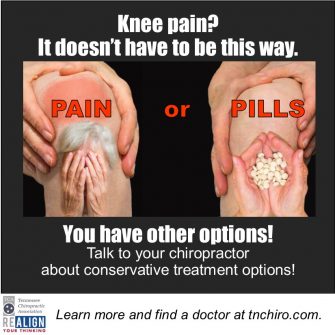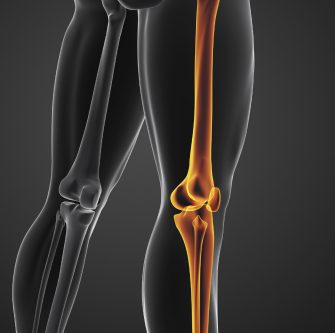Knee pain from osteoarthritis? You have options!
Knees. We use our knees for so many actions – walking, getting up, sitting down, climbing, running, bending over, kicking, driving, and the list goes on. They get so much use that we don’t even think about…at least not until there is a problem.
Whether knee pain begins as a result of an injury or as a simple matter of aging, the fact is that knee pain can have a significant impact on a person’s lifestyle. Osteoarthritis (OA) – degenerative arthritis – is the most common form of arthritis. The Arthritis Foundation reports that over 27 million Americans suffer from osteoarthritis and that the knee is one of the most frequently affected areas. There are a number of potential causes of osteoarthritis including:
- Age – most common factor
- Weight – each pound of body weight can add up to 4 pounds of pressure on your knees
- Hereditary –abnormal shape of the bones, genetic factors
- Gender – more women develop osteoarthritis than men
- Repetitive Stress injuries – occupations and hobbies that involve repeated kneeling, squatting or heavy lifting (55 lbs or more) put a person at higher risk
- Athletics – some sports such as soccer, tennis and running may contribute to the condition, although regular, moderate exercise may help prevent OA
- Other illnesses – other conditions such as metabolic disorders, iron overload, excess growth hormone or rheumatoid arthritis (2nd most common type of arthritis)
It can feel like your whole life is being brought to a screeching halt by your knee joints.
So what do you do?
“All people are different, both in their experience of pain and their goals,” says Timothy McAlindon, MD, chief of the division of rheumatology at Tufts Medical Center in Boston and lead author of the 2014 Osteoarthritis Research Society International (OARSI) guidelines for management of knee OA. “There’s also growing concern about the toxicity of drugs, particularly for people with osteoarthritis, who often have other conditions.”
He continues that those concerns are causing experts to favor non-drug treatments. In addition to the OARSI guidelines, recommendations issued by both the American Academy of Orthopaedic Surgeons (AAOS) in 2013 and the American College of Rheumatology (ACR) in 2012 place heavy emphasis on regular exercise and weight control as the best ways to obtain relief from knee OA pain. In fact, most treatments focus on relieving the pain symptoms.
In contrast, “Losing excess weight and building more muscle are also the only two things that the research shows can positively affect the course of knee osteoarthritis,” says Neil Segal, MD, associate professor of orthopaedics and rehabilitation and director of the Clinical Osteoarthritis Research Program at the University of Iowa in Iowa City. According to a large trial, a 5% body weight reduction was enough to reduce pain and improve mobility. A 10% loss could actually slow the disease process.
Unfortunately, the pain of knee OA often leads to inactivity (and weight gain)…
![]() which leads to weakened muscles…
which leads to weakened muscles…
which leads to progression of OA…
which causes more pain and less mobility…
which leads to further reduction in activity…
which leads to additional weight gain…
and the downward spiral continues.
In time, the patient is wheelchair or bed bound, in need of strong medications to deal with the pain and looking at surgery – or multiple surgeries. Thankfully, today we know there are options.
EDUCATION
A recommendation common to OA guidelines is education and self-management. Amanda Nelson, MD, a rheumatologist at the Thurston Arthritis Research Center at the University of North Carolina at Chapel Hill describes it this way: “Learning about your disease, including what’s likely to help and what’s likely to hurt. Many people, for example, think exercise is going to hurt their joints, when, in fact, it will improve their condition and their pain.”
EXERCISE
The Arthritis Foundation Online Panel and the Arthritis Today Reader Panel asked readers what pain relieving options they found to be effective. Out of the top 7 responses, 5 involved losing weight, stretching, or a form of healthy exercise such as walking.
Knee OA patients can work with their health care provider to develop a plan that is designed specifically for them – a plan that includes exercises to strengthen the muscles surrounding the knee and keep moving in ways that will not exacerbate the OA. As the OA status changes, the activity levels can be adjusted accordingly. One option that has been beneficial for many OA patients is tai chi. This low-impact exercise involves slow, flowing movements and is recommended by both the OARSI and ACR guidelines. Studies show it can help improve pain, stiffness and function up to 36% for OA sufferers.
ACUPUNCTURE
Acupuncture has also been shown to have beneficial effects for many knee OA patients. This therapy may be especially beneficial for those who have other health problems which limit their treatment options. A Cochrane Database review of trials showed 8 weeks of acupuncture treatment improved pain by 4 points and improved function by 11 points on a 20 point scale.
BIOMECHANICAL DEVICES
There is a plethora of braces, supports, wedges and other devices available over the counter that claim to help OA pain. Due to the variation of prefabricated supplies (including custom/fitted items) it has been difficult for researchers to issue a blanket statement that “Product X” is beneficial. However, enough data has been gathered to cause both the OARSI and ACR to include them in their list of options for people with knee OA. They suggest patients seek a biomechanical evaluation from a specialist to determine what, if any, products would be a benefit. As trained experts in the musculoskeletal system, chiropractors are an ideal resource. They can perform spinal manipulations for misalignments in the spinal column as well as determine if other misalignments in the extremities may be contributing to the patient’s OA pain. Then bracing, supports, taping, and/or specific targeted exercises may be recommended to the patient.
Not Just Treating the Symptom
Many with knee OA also have weak muscles in the legs or misalignments in the back and legs. As an expert in musculoskeletal system, the chiropractor can locate these other factors and address them as well. Additionally, for those in early stages or mild cases, the patient can be directed to exercises that will help prevent the progression, or at the very least, not contribute to it.
Just as there are many potential causes of knee OA pain, there are many potential treatments. Achieving pain relief and maintaining the ability to stay active and enjoy what life has to offer are very important reasons to see your chiropractor today for an evaluation.
 Yes, medications (such as opioids) and surgical options are always there, and in some cases are needed. However, in today’s world, there are many safe, effective treatments with much lower risks. OA pain doesn’t have to be a predetermined factor in your life. You might be surprised at how easy it can be to keep moving and lower your OA risks!
Yes, medications (such as opioids) and surgical options are always there, and in some cases are needed. However, in today’s world, there are many safe, effective treatments with much lower risks. OA pain doesn’t have to be a predetermined factor in your life. You might be surprised at how easy it can be to keep moving and lower your OA risks!
Talk to your chiropractor about how chiropractic care can help you and what you can do to live a healthier lifestyle to change or eliminate your OA risk factors. If you don’t have a regular chiropractor, you can find a TCA member doctor near your home, work or school at https://www.tnchiro.com/find-a-doctor/ .
RESOURCES:
Delzell, Emily. “The Best Ways to Ease Knee Pain Without Drugs: Knee Osteoarthritis – Finding Drug-free Pain Relief.” Arthritis Foundation – arthritis.org
Osteoarthritis of the Knee (Degenerative Arthritis of the Knee). WedMD
